All the best for 2019! Gelukkig Nieuwjaar, as we say in Dutch. This first week of the new year we'll post only film specials. 53 years ago, at the beginning of 1966, everything turned Batman. The legendary TV show dominated television, merchandising - an advertisement for the show made it to the Super Bowl! The show even was made into a theatrically released film, also starring Adam West as Batman / Bruce Wayne and Burt Ward as Robin / Dick Grayson. In Batman: The Movie (Leslie H. Martinson, 1966) the Dynamic Duo faces four super-villains - The Catwoman, The Joker, The Riddler and The Penguin - who plan to hold the world for ransom with the help of a secret invention that instantly dehydrates people.
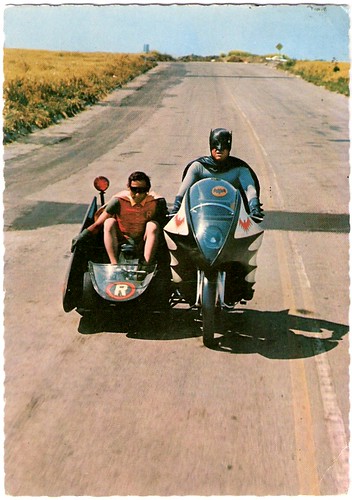
Dutch postcard by Vita Nova, Schiedam, no. B/10/49. Sent by mail in 1967. Photo: National Periodical Publications Inc. Publicity still for the 20th Century-Fox Film Batman: The Movie (Leslie H. Martinson, 1966) with Burt Ward as Robin and Adam West as Batman.

Dutch postcard by Vita Nova, Schiedam, no. 1 B/10/49. Photo: National Periodical Publications Inc. / 20th Century Fox. Publicity still for Batman: The Movie (Leslie Martinson, 1966).
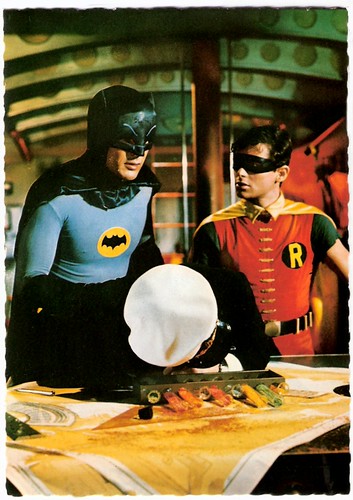
Dutch postcard by Vita Nova, Schiedam, no. 2 B/10/49. Photo: National Periodical Publications Inc. / 20th Century Fox. Publicity still for Batman: The Movie (Leslie Martinson, 1966).
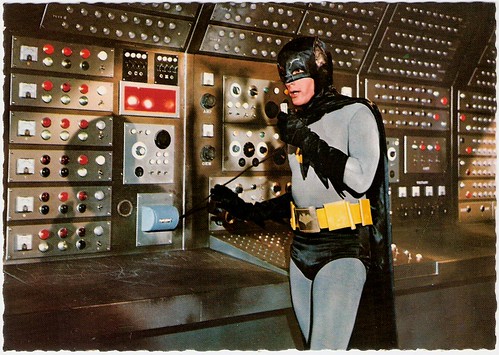
Dutch postcard by Vita Nova, Schiedam, no. 4 B/10/49. Photo: National Periodical Publications Inc. Publicity still for the 20th Century-Fox Film Batman: The Movie (Leslie Martinson, 1966)..
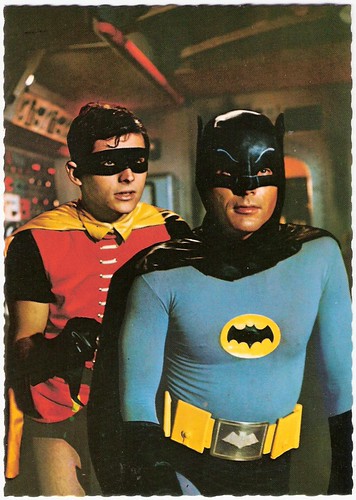
Dutch postcard by Vita Nova, Schiedam, no. 5 B/10/49. Photo: National Periodical Publications Inc. / 20th Century Fox. Publicity still for Batman: The Movie (Leslie Martinson, 1966).
Batman (Leslie H. Martinson, 1966) or Batman: The Movie is an American superhero film based on the Batman television series and the first full-length theatrical adaptation of the DC Comics character Batman. Released by 20th Century Fox, the film reprised Adam West as Batman and Burt Ward as Robin. The film hit theatres two months after the last episode of the first season of the television series. The film includes most members of the original TV cast, except for Lee Meriwether as Catwoman, the character previously played by Julie Newmar in two episodes of the series' first season.
When Batman and Robin get a tip that Commodore Schmidlapp (Reginald Denny) is in danger aboard his yacht, they launch a rescue mission using the Batcopter. As Batman descends on the bat ladder to land on the yacht, it suddenly vanishes beneath him. He rises out of the sea with a shark attacking his leg. After Batman dislodges it with bat-shark repellent, the shark explodes. Batman and Robin head back to Commissioner Gordon's (Neil Hamilton) office, where they deduce that the tip was a set-up by the United Underworld, a gathering of four of the most powerful villains in Gotham City: The Catwoman (Lee Meriwether), The Riddler (Frank Gorshin), The Penguin (Burgess Meredith), and The Joker (Cesar Romero).
The United Underworld equip themselves with a dehydrator that can turn humans into dust (an invention of Schmidlapp, who is unaware that he has been kidnapped), a submarine made to resemble a penguin, and their three pirate henchmen (Bluebeard (Gil Perkins), Morgan (Dick Crockett) and Quetch (George Sawaya)). It is revealed the yacht was really a projection. When Batman and Robin return to a buoy concealing a projector, they are trapped on the buoy by a magnet and targeted by torpedoes. They use a radio detonator to destroy two of the missiles, and a porpoise sacrifices itself to intercept the last one.
Catwoman, disguised as Soviet journalist "Kitayna Ireyna Tatanya Kerenska Alisoff" (acronym as Kitka), helps the group kidnap Bruce Wayne and pretends to be kidnapped with him, as part of a plot to lure Batman and finish him off with another of the Penguin's explosive animals (not knowing that Bruce Wayne is Batman's alter-ego). After Bruce Wayne escapes captivity, the Penguin disguises himself as the Commodore and schemes his way into the Batcave along with five dehydrated henchmen. This plan fails when the henchmen unexpectedly disappear into antimatter once struck: The Penguin mistakenly rehydrated them with heavy water, used to recharge the Batcave's atomic pile.
Ultimately, Batman and Robin are unable to prevent the kidnapping of the dehydrated United World Organization's Security Council. Giving chase in the batboat to retrieve them (and Miss Kitka, presumed by the duo as still captive), Robin uses a sonic charge weapon to disable The Penguin's submarine and force it to surface, where a fistfight ensues. Although Batman and Robin win the fight, Batman is heartbroken to find out that his 'true love' Miss Kitka is actually Catwoman when her mask falls off. Commodore Schmidlapp accidentally breaks the vials containing the powdered Council members, mixing them together. Batman sets to work, constructing an elaborate filter to separate the mingled dust. Robin asks him whether it might be in the world's best interests for them to alter the dust samples so that humans can no longer harm one another. In response, Batman says that they cannot do so, reminding Robin of the fate of the Penguin's henchmen and their tainted rehydration, and can only hope for people, in general, to learn to live together peacefully on their own.
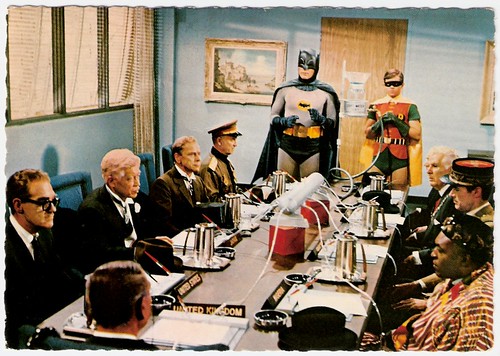
Dutch postcard by Vita Nova, Schiedam, no. 7 B/10/49. Photo: National Periodical Publications Inc. Publicity still for the 20th Century-Fox Film Batman: The Movie (Leslie Martinson, 1966).

Dutch postcard by Vita Nova, Schiedam, no. 8 B/10/49. Photo: National Periodical Publications Inc. Publicity still for the 20th Century-Fox Film Batman: The Movie (Leslie Martinson, 1966).
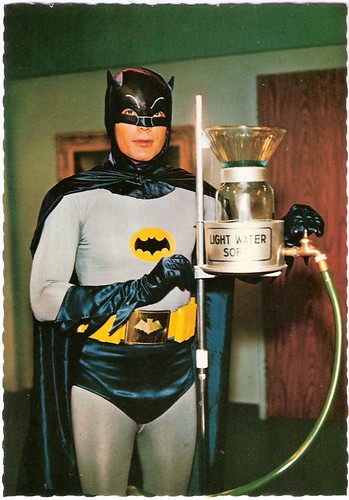
Dutch postcard by Vita Nova, Schiedam, no. 9 B/10/49. Photo: National Periodical Publications Inc. Publicity still for the 20th Century-Fox Film Batman: The Movie (Leslie Martinson, 1966).
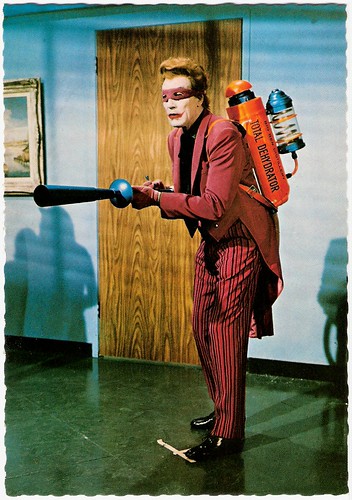
Dutch postcard by Vita Nova, Schiedam, no. 10 B/10/49. Photo: National Periodical Publications Inc. Publicity still for the 20th Century-Fox Film Batman: The Movie (Leslie H. Martinson, 1966) with Cesar Romero as The Joker. Note the tape mark Romero had to stand on to be in the frame.
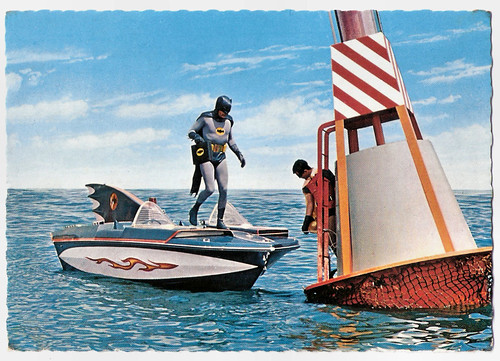
Dutch postcard by Vita Nova, Schiedam, no. B /10/49. Photo: National Periodical Publications Inc. Publicity still for the 20th Century-Fox Film Batman: The Movie (Leslie Martinson, 1966).
With the world watching, the Security Council is re-hydrated. All of the members are restored alive and well but continue to squabble amongst themselves, totally oblivious of their surroundings, but each of them now speaks the language and displays the stereotypical mannerisms of a nation other than their own. Batman quietly expresses his sincere hope to Robin that this "mixing of minds" does more good than it does harm.
The duo quietly leave United World Headquarters by climbing out of the window and descending on their bathrobes. Of the three new Batvehicles which first appeared in the Batman film, only the Batcycle properly crossed over into the TV series as the budgetary limits of the TV series precluded the full use of the others. While the Batcopter and Batboat from the film appeared briefly in episodes, they primarily did so in the form of stock footage scenes from the film intercut into the series.
The film includes most members of the original TV cast: Alan Napier as Alfred, Madge Blake as Aunt Harriet, and Stafford Repp as Chief O'Hara also reprised their roles. Julie Newmar had other commitments at that time and was replaced by Lee Meriwether (Miss America 1955) in the film. Catwoman was nonetheless played by Newmar once again in the following eleven episodes of season two of the series. Eartha Kitt would then play Catwoman in three episodes of season three. For Reginald Denny, Batman: The Movie (1966) was his final film appearance. Director Leslie H. Martinson directed a pair of the television series season-one episodes: The Penguin Goes Straight and Not Yet, He Ain't. Batman premiered at the Paramount Theatre in Austin, Texas on 30 July 1966, between the first and second seasons of the TV series. It was moderately successful at the box office.
The film has received generally positive reviews over the years. Phil Lindholm at IMDb: "Thanks to its 'hip' humour, an eye-popping kaleidoscope of bizarre colour backgrounds and a cast of "guest villains" second to none: Julie Newmar, Cesar Romero, Anne Baxter, Burgess Meredith (the list goes on and on) the show was an immediate smash. Suddenly, America became "batty" and it's popularity was so great that stars scrambled for a chance to appear on the program. (...) despite mass bookings in every theatre available, the film came and went. But, seen today, Batman holds up well, capturing perfectly what was one of the biggest fads to come along in the sixties."
TCH at TimeOut London: "With a flip script by Lorenzo Semple Jr, it has a few inspired slapstick sequences, but the emphatic senselessness gradually becomes tiresome. More surprisingly, the production work is by and large excellent. Nelson Riddle's musical cues are fun, and the design still looks sleek today - I'd choose Adam West's Batmobile over Michael Keaton's any day." Jeremy Beday at AllMovie: "The entire cast is excellent, particularly West and Ward, who distinguish themselves among a standout list with hilariously straight-faced performances. The film includes some truly memorable scenes, highlighted by a particularly tenacious shark with a vertical leap that would put Spud Webb to shame and a bomb on the waterfront with no place to explode (nuns, infants and lovebirds beware!).
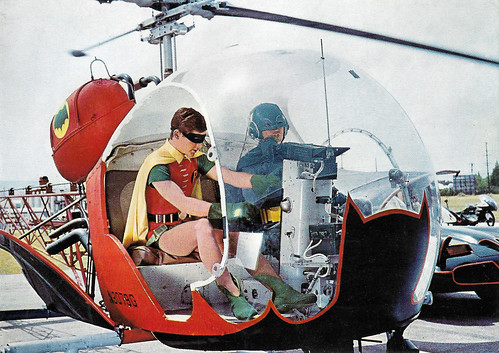
Dutch promotional postcard for Okee. Publicity still for Batman: The Movie (Leslie H. Martinson, 1966) with Burt Ward as Robin and Adam West as Batman.
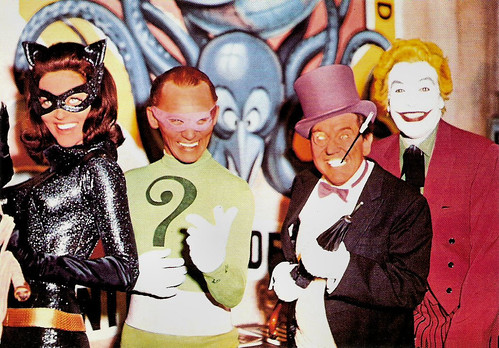
Dutch promotional postcard for Okee. Photo: National Periodical Publications Inc. / 20th Century Fox. Publicity still for Batman: The Movie (Leslie H. Martinson, 1966) with Lee Meriwether as The Catwoman/Kitka, Frank Gorshin as The Riddler, Burgess Meredith as The Penguin, and Cesar Romero as The Joker.
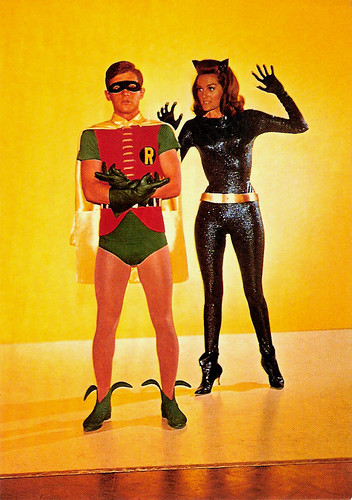
Dutch promotional postcard for Okee. Photo: National Periodical Publications Inc. / 20th Century Fox. Publicity still for Batman: The Movie (Leslie H. Martinson, 1966) with Burt Ward and Lee Meriwether as Catwoman.
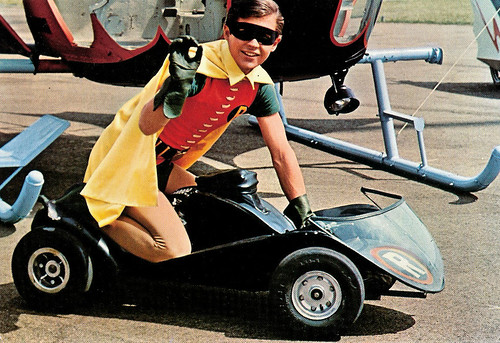
Spanish postcard by Postal Oscarcolor S.A., Hospitalet (Barcelona), no. 693. Publicity still for Batman: The Movie (Leslie H. Martinson, 1966).
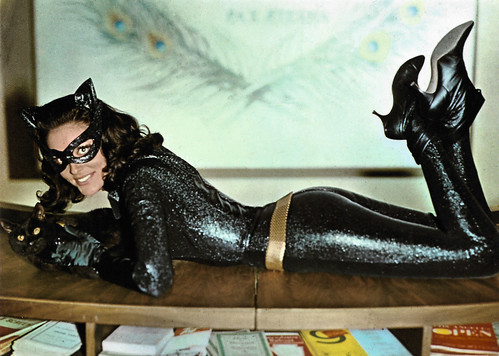
British postcard by Klasik Kards, London, no. 1557. Publicity still for Batman: The Movie (Leslie H. Martinson, 1966) with Lee Meriwether as Catwoman.
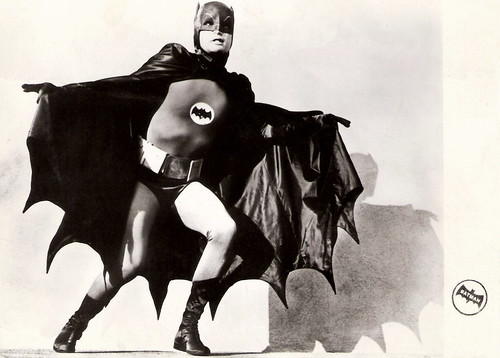
Dutch postcard by KRO.
Sources: Jeremy Beday (AllMovie -page now defunct), Phil Lindholm (IMDb), TCH (TimeOut London), Wikipedia and IMDb.
This post was last updated on 15 Novermber 2024.

Dutch postcard by Vita Nova, Schiedam, no. B/10/49. Sent by mail in 1967. Photo: National Periodical Publications Inc. Publicity still for the 20th Century-Fox Film Batman: The Movie (Leslie H. Martinson, 1966) with Burt Ward as Robin and Adam West as Batman.

Dutch postcard by Vita Nova, Schiedam, no. 1 B/10/49. Photo: National Periodical Publications Inc. / 20th Century Fox. Publicity still for Batman: The Movie (Leslie Martinson, 1966).

Dutch postcard by Vita Nova, Schiedam, no. 2 B/10/49. Photo: National Periodical Publications Inc. / 20th Century Fox. Publicity still for Batman: The Movie (Leslie Martinson, 1966).

Dutch postcard by Vita Nova, Schiedam, no. 4 B/10/49. Photo: National Periodical Publications Inc. Publicity still for the 20th Century-Fox Film Batman: The Movie (Leslie Martinson, 1966)..

Dutch postcard by Vita Nova, Schiedam, no. 5 B/10/49. Photo: National Periodical Publications Inc. / 20th Century Fox. Publicity still for Batman: The Movie (Leslie Martinson, 1966).
A gathering of four of the most powerful villains in Gotham City
Batman (Leslie H. Martinson, 1966) or Batman: The Movie is an American superhero film based on the Batman television series and the first full-length theatrical adaptation of the DC Comics character Batman. Released by 20th Century Fox, the film reprised Adam West as Batman and Burt Ward as Robin. The film hit theatres two months after the last episode of the first season of the television series. The film includes most members of the original TV cast, except for Lee Meriwether as Catwoman, the character previously played by Julie Newmar in two episodes of the series' first season.
When Batman and Robin get a tip that Commodore Schmidlapp (Reginald Denny) is in danger aboard his yacht, they launch a rescue mission using the Batcopter. As Batman descends on the bat ladder to land on the yacht, it suddenly vanishes beneath him. He rises out of the sea with a shark attacking his leg. After Batman dislodges it with bat-shark repellent, the shark explodes. Batman and Robin head back to Commissioner Gordon's (Neil Hamilton) office, where they deduce that the tip was a set-up by the United Underworld, a gathering of four of the most powerful villains in Gotham City: The Catwoman (Lee Meriwether), The Riddler (Frank Gorshin), The Penguin (Burgess Meredith), and The Joker (Cesar Romero).
The United Underworld equip themselves with a dehydrator that can turn humans into dust (an invention of Schmidlapp, who is unaware that he has been kidnapped), a submarine made to resemble a penguin, and their three pirate henchmen (Bluebeard (Gil Perkins), Morgan (Dick Crockett) and Quetch (George Sawaya)). It is revealed the yacht was really a projection. When Batman and Robin return to a buoy concealing a projector, they are trapped on the buoy by a magnet and targeted by torpedoes. They use a radio detonator to destroy two of the missiles, and a porpoise sacrifices itself to intercept the last one.
Catwoman, disguised as Soviet journalist "Kitayna Ireyna Tatanya Kerenska Alisoff" (acronym as Kitka), helps the group kidnap Bruce Wayne and pretends to be kidnapped with him, as part of a plot to lure Batman and finish him off with another of the Penguin's explosive animals (not knowing that Bruce Wayne is Batman's alter-ego). After Bruce Wayne escapes captivity, the Penguin disguises himself as the Commodore and schemes his way into the Batcave along with five dehydrated henchmen. This plan fails when the henchmen unexpectedly disappear into antimatter once struck: The Penguin mistakenly rehydrated them with heavy water, used to recharge the Batcave's atomic pile.
Ultimately, Batman and Robin are unable to prevent the kidnapping of the dehydrated United World Organization's Security Council. Giving chase in the batboat to retrieve them (and Miss Kitka, presumed by the duo as still captive), Robin uses a sonic charge weapon to disable The Penguin's submarine and force it to surface, where a fistfight ensues. Although Batman and Robin win the fight, Batman is heartbroken to find out that his 'true love' Miss Kitka is actually Catwoman when her mask falls off. Commodore Schmidlapp accidentally breaks the vials containing the powdered Council members, mixing them together. Batman sets to work, constructing an elaborate filter to separate the mingled dust. Robin asks him whether it might be in the world's best interests for them to alter the dust samples so that humans can no longer harm one another. In response, Batman says that they cannot do so, reminding Robin of the fate of the Penguin's henchmen and their tainted rehydration, and can only hope for people, in general, to learn to live together peacefully on their own.

Dutch postcard by Vita Nova, Schiedam, no. 7 B/10/49. Photo: National Periodical Publications Inc. Publicity still for the 20th Century-Fox Film Batman: The Movie (Leslie Martinson, 1966).

Dutch postcard by Vita Nova, Schiedam, no. 8 B/10/49. Photo: National Periodical Publications Inc. Publicity still for the 20th Century-Fox Film Batman: The Movie (Leslie Martinson, 1966).

Dutch postcard by Vita Nova, Schiedam, no. 9 B/10/49. Photo: National Periodical Publications Inc. Publicity still for the 20th Century-Fox Film Batman: The Movie (Leslie Martinson, 1966).

Dutch postcard by Vita Nova, Schiedam, no. 10 B/10/49. Photo: National Periodical Publications Inc. Publicity still for the 20th Century-Fox Film Batman: The Movie (Leslie H. Martinson, 1966) with Cesar Romero as The Joker. Note the tape mark Romero had to stand on to be in the frame.

Dutch postcard by Vita Nova, Schiedam, no. B /10/49. Photo: National Periodical Publications Inc. Publicity still for the 20th Century-Fox Film Batman: The Movie (Leslie Martinson, 1966).
Nuns, infants and lovebirds beware!
With the world watching, the Security Council is re-hydrated. All of the members are restored alive and well but continue to squabble amongst themselves, totally oblivious of their surroundings, but each of them now speaks the language and displays the stereotypical mannerisms of a nation other than their own. Batman quietly expresses his sincere hope to Robin that this "mixing of minds" does more good than it does harm.
The duo quietly leave United World Headquarters by climbing out of the window and descending on their bathrobes. Of the three new Batvehicles which first appeared in the Batman film, only the Batcycle properly crossed over into the TV series as the budgetary limits of the TV series precluded the full use of the others. While the Batcopter and Batboat from the film appeared briefly in episodes, they primarily did so in the form of stock footage scenes from the film intercut into the series.
The film includes most members of the original TV cast: Alan Napier as Alfred, Madge Blake as Aunt Harriet, and Stafford Repp as Chief O'Hara also reprised their roles. Julie Newmar had other commitments at that time and was replaced by Lee Meriwether (Miss America 1955) in the film. Catwoman was nonetheless played by Newmar once again in the following eleven episodes of season two of the series. Eartha Kitt would then play Catwoman in three episodes of season three. For Reginald Denny, Batman: The Movie (1966) was his final film appearance. Director Leslie H. Martinson directed a pair of the television series season-one episodes: The Penguin Goes Straight and Not Yet, He Ain't. Batman premiered at the Paramount Theatre in Austin, Texas on 30 July 1966, between the first and second seasons of the TV series. It was moderately successful at the box office.
The film has received generally positive reviews over the years. Phil Lindholm at IMDb: "Thanks to its 'hip' humour, an eye-popping kaleidoscope of bizarre colour backgrounds and a cast of "guest villains" second to none: Julie Newmar, Cesar Romero, Anne Baxter, Burgess Meredith (the list goes on and on) the show was an immediate smash. Suddenly, America became "batty" and it's popularity was so great that stars scrambled for a chance to appear on the program. (...) despite mass bookings in every theatre available, the film came and went. But, seen today, Batman holds up well, capturing perfectly what was one of the biggest fads to come along in the sixties."
TCH at TimeOut London: "With a flip script by Lorenzo Semple Jr, it has a few inspired slapstick sequences, but the emphatic senselessness gradually becomes tiresome. More surprisingly, the production work is by and large excellent. Nelson Riddle's musical cues are fun, and the design still looks sleek today - I'd choose Adam West's Batmobile over Michael Keaton's any day." Jeremy Beday at AllMovie: "The entire cast is excellent, particularly West and Ward, who distinguish themselves among a standout list with hilariously straight-faced performances. The film includes some truly memorable scenes, highlighted by a particularly tenacious shark with a vertical leap that would put Spud Webb to shame and a bomb on the waterfront with no place to explode (nuns, infants and lovebirds beware!).

Dutch promotional postcard for Okee. Publicity still for Batman: The Movie (Leslie H. Martinson, 1966) with Burt Ward as Robin and Adam West as Batman.

Dutch promotional postcard for Okee. Photo: National Periodical Publications Inc. / 20th Century Fox. Publicity still for Batman: The Movie (Leslie H. Martinson, 1966) with Lee Meriwether as The Catwoman/Kitka, Frank Gorshin as The Riddler, Burgess Meredith as The Penguin, and Cesar Romero as The Joker.

Dutch promotional postcard for Okee. Photo: National Periodical Publications Inc. / 20th Century Fox. Publicity still for Batman: The Movie (Leslie H. Martinson, 1966) with Burt Ward and Lee Meriwether as Catwoman.

Spanish postcard by Postal Oscarcolor S.A., Hospitalet (Barcelona), no. 693. Publicity still for Batman: The Movie (Leslie H. Martinson, 1966).

British postcard by Klasik Kards, London, no. 1557. Publicity still for Batman: The Movie (Leslie H. Martinson, 1966) with Lee Meriwether as Catwoman.

Dutch postcard by KRO.
Sources: Jeremy Beday (AllMovie -page now defunct), Phil Lindholm (IMDb), TCH (TimeOut London), Wikipedia and IMDb.
This post was last updated on 15 Novermber 2024.
No comments:
Post a Comment